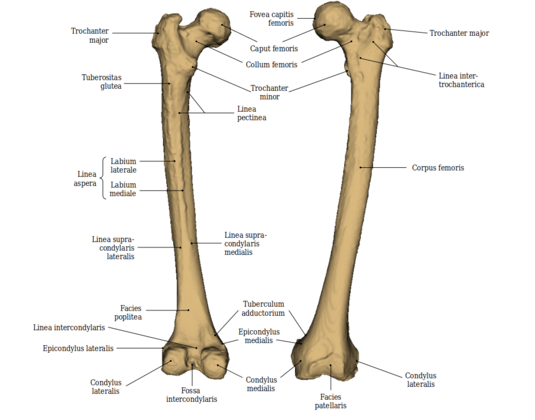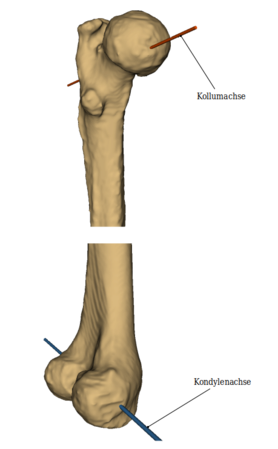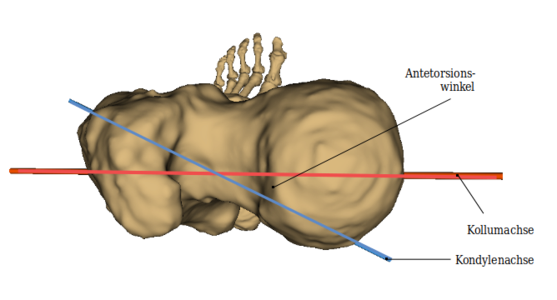Oberschenkelknochen/en: Unterschied zwischen den Versionen
Becher (Diskussion | Beiträge) (Die Seite wurde neu angelegt: „===Shaft (Corpus femoris)===“) |
Becher (Diskussion | Beiträge) (Die Seite wurde neu angelegt: „The shaft forms the strong middle part of the thigh bone and begins below the rolling mounds. The dorsally located reinforcement bar (<i>Linea aspera</i>) serv…“) |
||
| Zeile 34: | Zeile 34: | ||
===Shaft (Corpus femoris)=== | ===Shaft (Corpus femoris)=== | ||
| − | + | The shaft forms the strong middle part of the thigh bone and begins below the rolling mounds. The dorsally located reinforcement bar (<i>Linea aspera</i>) serves as an attachment for almost all femoral adductors, but also ensures high stability with a small diameter. | |
| − | + | The <i>Linea aspera</i> consists of a central (<i>Labium medial</i>) and a lateral groin (<i>Labium lateral</i>). In the middle of the shaft both groins are still close together. However, they divide up and down. Proximally, the <i>labium laterale</i> merges into a rough surface (<i> tuberositas glutaea</i>) and the <i>labium medial</i> is continued by the <i>line pectina</i> under the small rolling mound. Distally the two groins divide into the <i>Linea supracondylaris medialis</i> and <i>Linea supracondylaris lateralis</i>. These two lines limit the triangular bone field <i>Facies poplitea</i>. | |
Version vom 3. Januar 2020, 14:50 Uhr
Inhaltsverzeichnis
General information
The thigh (femur) is the part of the leg between hip and lower leg. The bony basis is the femur (Os femoris). This tubular bone is filled inside with spongy bone trabeculae (Spongiosa). Thus, a high stability is achieved with a low weight. With age, the proportion of bone trabeculae decreases, which causes the bone to break more quickly.
| left lower extremity | left femur | right femur |
<segmenter>https://dornheim.cloud/index.php/apps/segmenter/embedding/view?identifier=IX5iSfKVXeXr</segmenter>
Anatomy of the bone
Head (Caput ossis femoris)
The head has an almost spherical joint surface. This is connected to the pelvic bones and thus forms the hip joint. In the middle of the head is the hip basket pit (Fovea capitis femoris). This cavity is the point of passage for a ligament (ligamentum capitis ossis femoris), which surrounds the artery supplying the femoral head. The head merges into the femoral neck at a slight angle.
Neck (Collum ossis femoris)
The femoral neck becomes thicker from proximal to distal and is flattened from ventral to dorsal.
At the lateral end of the neck there are two bony humps, so-called rolling hills. The large trochanter (trochanter major) is located ventrally. It forms a starting point for the gluteal muscles. The dorsal small trochanter (trochanter minor) also serves as a starting point for various thigh muscles. Another starting point for the muscles is a depression (trochanteric fossa) between the neck and the large trochanteric mound as well as the connections between the two trochanteric mounds. Ventrally, the two mounds are connected via the Linea intertrochanterica and dorsally via the Crista intertrochanterica.
Shaft (Corpus femoris)
The shaft forms the strong middle part of the thigh bone and begins below the rolling mounds. The dorsally located reinforcement bar (Linea aspera) serves as an attachment for almost all femoral adductors, but also ensures high stability with a small diameter.
The Linea aspera consists of a central (Labium medial) and a lateral groin (Labium lateral). In the middle of the shaft both groins are still close together. However, they divide up and down. Proximally, the labium laterale merges into a rough surface ( tuberositas glutaea) and the labium medial is continued by the line pectina under the small rolling mound. Distally the two groins divide into the Linea supracondylaris medialis and Linea supracondylaris lateralis. These two lines limit the triangular bone field Facies poplitea.
Unteres Ende
Am unteren Ende ist der Oberschenkelknochen zu zwei mit Knorpel überzogenen nach außen gekrümmten Gelenkknorren (Condylus medialis und lateralis) verbreitert. Mit dem Schienbein (Tibia) zusammen bilden sie das Kniegelenk. Vorne vereinigen sich die Knorren zu einer nach außen gekrümmten Gelenkfläche (Facies patellaris). Diese bildet die Verbindung zur Kniescheibe. Außerdem besitzen die Knorren jeweils als Aufsatz kleine Knochenvorsprünge (Epicondylus medialis und Epicondylus lateralis). Hinten trennt eine Grube (Fossa intercondylaris), begrenzt durch die Linea intercondylaris, die beiden Gelenkknorren voneinander.
Achsen und Winkel
Kollumachse
Die Kollumachse (auch Schenkelhalsachse genannt) beschreibt die Längsachse des Schenkelhalses.
Kondylenachse
Die Kondylenachse ist die vordere Grenze der Fossa intercondylaris und stellt somit eine Kondylenhalbierende dar.
CCD-Winkel
Der Winkel zwischen der Längsachse des Schenkelhalses und der Hauptachse des Schaftes wird Centrum-Collum-Diaphysen-Winkel (CCD-Winkel) genannt. Je nach Alter und Geschlecht ist der Winkel verschieden groß. Beim Neugeborenen und Säugling beträgt der Winkel bis 150 Grad. Mit zunehmendem Alter nimmt er beständig ab und beträgt beim Erwachsenen schließlich 120 bis 130 Grad. Aufgrund der veränderten Beanspruchung der Knochen während des Wachstums kommt es zu einem kontinuierlichen Knochenumbau. Dieser ist die Ursache für die Veränderung des CCD-Winkels mit fortschreitendem Alter.
Antetorsionswinkel
Der Torsionswinkel ist die Verdrehung der Querachsen des distalen und proximalen Femurendes. Das distale Ende ist im Vergleich zum proximalen nach einwärts (in Richtung Medianebene) um etwa 12–20 Grad gedreht.
weiterführende Links


